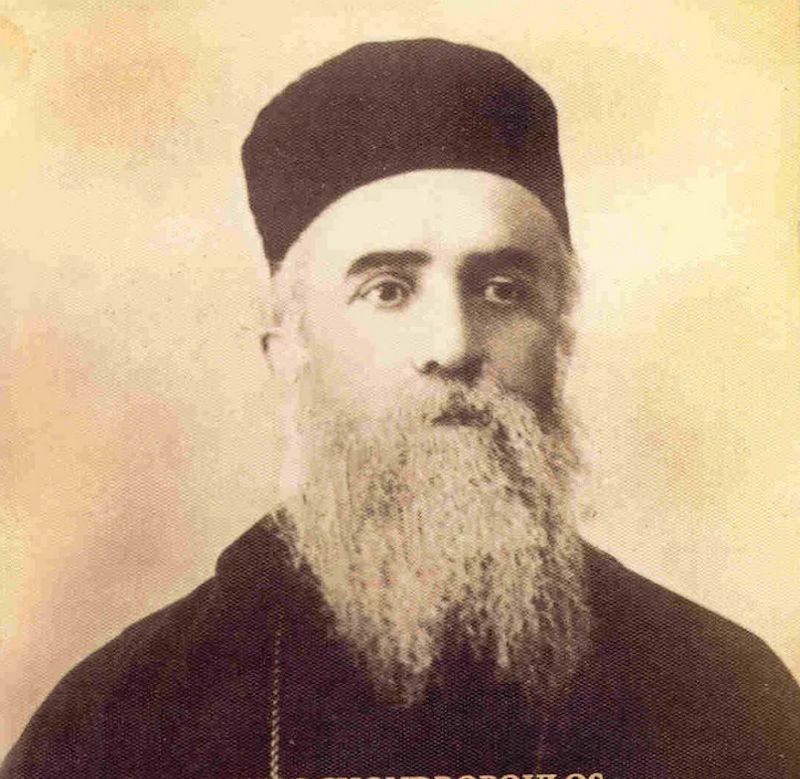
Saint Nectarios of Aegina (1 October 1846 – 8 November 1920), Greek: Άγιος Νεκτάριος Αιγίνης, Metropolitan of Pentapolis and Wonderworker of Aegina, was officially recognized as a Saint by the Ecumenical Patriarchate of Constantinople in 1961. His Feast Day is celebrated every year on 9 November.
Anastasios Kephalas, later Nectarios, was born on 1 October 1846 in Selymbria (today Silivri, Istanbul) in the Ottoman Empire to a poor family. His parents, Dimos and Maria Kephalas, were pious Christians but not wealthy.
At the age of 14, he moved to Constantinople (Istanbul) to work and further his education. In 1866, at age 20, he moved to the island of Chios to take a teaching post. On November 7, 1876, he became a monk, at age 30, in the Monastery of Nea Moni, for he had long wished to embrace the ascetic life.
Three years after becoming a monk he was ordained a Deacon, taking the name Nectarios. He graduated from the University of Athens in 1885. During his years as a student of the University of Athens he wrote many books, pamphlets, and Bible commentaries.
Following his graduation he went to Alexandria, Egypt, where he was ordained a priest and served the Church of Saint Nicholas in Cairo. He was consecrated Metropolitan bishop of Pentapolis (an ancient diocese in Cyrenaica, in what is now Libya) by the Greek Orthodox Patriarch Sophronios in 1889.
He served as a Bishop in Cairo for one year. Nectarios was very popular with the people, which gave rise to jealousy among his colleagues. They were able to persuade his superior that Nectarios had ambitions to displace the Patriarch. Nectarios was suspended from his post without explanation. He then returned to Greece in 1891, and spent several years as a preacher (1891–1894). He was then director of the Rizarios Ecclesiastical School for the education of priests in Athens for fifteen years. He developed many courses of study, and wrote numerous books, while preaching widely throughout Athens.
In 1904, at the request of several nuns, he established Holy Trinity Monastery for them on the island of Aegina.
Nectarios ordained two women as deaconesses in 1911. Up to the 1950s, a few Greek Orthodox nuns also became monastic deaconesses. In 1986, Christodoulos, the metropolitan of Demetrias and later archbishop of Athens and all of Greece, ordained a woman deacon in accordance with the “ritual of St. Nektarios” (the ancient Byzantine text St. Nektarios had used).
In December 1908, at the age of 62, St. Nectarios resigned from his post as school director and withdrew to the Holy Trinity Convent on Aegina, where he lived out the rest of his life as a monk. He wrote, published, preached, and heard confessions. He also tended the gardens, carried stones, and helped with the construction of the monastery buildings that were built with his own funds.
St. Nectarios died on November 8, 1920, at the age of 74, following hospitalization for prostate cancer and two months of treatment. His body was taken to the Holy Trinity Convent, where he was buried by his best friend St Savvas of Kalymnos, who later painted the first icon of St. Nectarios. The funeral of St. Nectarios was attended by multitudes of people from all parts of Greece and Egypt. His anathema was not lifted by the Alexandrian Patriarchate until 1998.
The relics of St. Nectarios were removed from the grave on 2 September 1953. Official recognition of Nectarios as a Saint by the Ecumenical Patriarchate of Constantinople took place on 20 April 1961. The Feast Day of St. Nectarios is celebrated every year on 9 November.